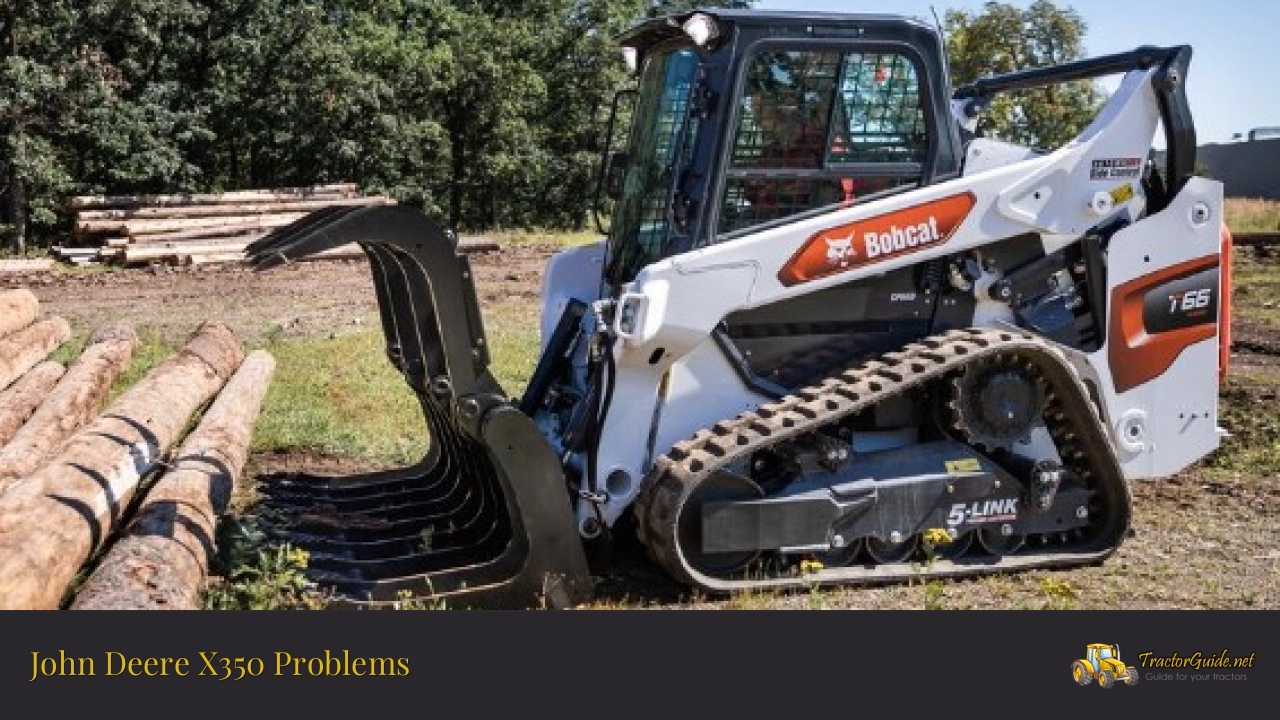On this page we will give you detailed information about Bobcat T66 Problems. The topics that will be examined in general terms under the title Bobcat T66 Problems will be engine, hydraulics, electrical and drive system. We will examine the problems that occur under these headings in the finest detail and provide you with solutions.
The Bobcat T66 compact track loader is a powerful machine with an impressive driveline system. It features a 146.5 cu.in (2.4L) Bobcat Doosan D24 four-cylinder turbo diesel engine that produces 74 hp (55.2 kW). It also has either 1-speed or 2-speed hydrostatic transmission and a 17.6 gpm (66.5 lpm) pump with 3550 psi (245 bar) pressure rating on its hydraulic system, allowing it to tackle even the most demanding jobs with ease.
The vertical lift loader boom, solid mounted or torsion suspension undercarriage, and rubber tracks make this machine ideal for a wide range of applications while providing reliable performance in any conditions it faces – the max lift height is 120″ (3050 mm), dump height 94.3″ (2395 mm), rated operating capacity 2450 lbs(1110 kg), and tipping load 7000 lbs(3175 kg).
Bobcat T66 Problems: Engine
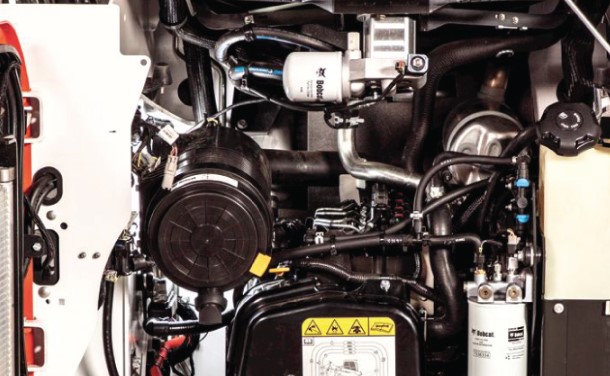
Engine starts up hard or won’t start
- The air trapped in the fuel system must be bled in order to maintain proper performance.
- To avoid plugging of the fuel filter, it is important to regularly change the filter element.
- If injection nozzles become clogged or faulty, a new kit of correctly balanced nozzles should be installed for optimal operation.
- In order to prevent water from entering and damaging the fuel system, any contaminated fuel must be changed and repairs conducted as necessary on the fuel system itself.
- Any misalignment of valves can cause malfunctions; thus an adjustment is required to ensure accurate functioning of all components within this area of your vehicle’s engine compartment.
- When faced with a faulty fuel injection pump, either installing a new pump or rebuilding it may resolve any issues experienced with its performance level .
Engine stalls after starting
- The air filter is found to be dirty and requires servicing or replacement.
- Clogging of the fuel filter has been detected, thus necessitating either cleaning or changing of the same.
- Loosening of the fuel injection pump has been observed, thereby requiring an inspection for any fuel leakage and subsequent tightening of it accordingly.
- Dirty or defective fuel injectors need to be changed or cleaned for effective functioning.
- Malfunctioning of the fuel injection pump demands a repair job or its replacement if necessary
Engine stalls after running
- The engine’s coolant temperature should be normalized by warming it up.
- The fuel filter element needs to be changed due to dirtiness.
- Air must be bled from the fuel system in order for optimal performance and efficiency.
- Injection nozzles that are either damaged or dirty need to be cleaned or replaced accordingly.
- To ensure proper functioning, the timing of the fuel injection pump requires adjustment as recommended by professionals in the industry
Engine stalls at low idle speed
- Services provided by our technicians include adjusting the idle speed to the correct levels in cases where it has been incorrectly set.
- When fuel injection pumps become damaged, they can be replaced or repaired as needed by our expert staff.
- Fuel injectors that are defective will be professionally replaced with new ones swiftly and efficiently.
- If improper valve clearance is detected, we have the expertise to make adjustments which restore performance back to its optimal level.
Loss of engine power
- The air cleaner element of the vehicle must be either cleaned or replaced in order to ensure a clean and sufficient air flow.
- Fuel injection nozzles may become faulty or clogged; they should be inspected and replaced if necessary.
- It is important to check the fuel injection pressure and make adjustments as needed for optimum performance.
- Valve clearance must be checked regularly, with any discrepancies adjusted as required for optimal operation of the engine system.
- Low idle speed must be accurately set according to manufacturer’s guidelines for proper functioning of the engine system.
- The fuel hoses and lines should always remain free from dirt build-up in order to avoid poor performance due to clogging issues arising from dirt accumulation along the lines/hoses used by the fuel delivery systems of vehicles .
- If there are any signs that point towards a damaged cylinder-head gasket, it is essential that this component is quickly replaced without further delay so as not to cause any additional damage which might result in costly repairs down the line..
- Any indications that piston rings have become damaged or leaking require an immediate replacement for avoiding extensive damage caused by such malfunctions over time..
Engine overheats
- It is essential to check the coolant level and add more if it is low.
- Low engine oil levels require filling up to the required amount.
- A defective radiator cap or a clogged radiator core may necessitate installing a new cap or cleaning the radiator respectively.
- If a fan belt has broken or worn, it must be replaced as soon as possible for proper engine performance.
- An overloaded engine should have its load reduced in order to prevent damage and other issues from arising with prolonged use of such conditions
Oil pressure is low
- The engine oil level is insufficient – it must be replenished as soon as possible.
- The engine oil filter has become plugged and should be serviced or replaced immediately.
- Incorrect viscosity of the engine oil is being used, and must be changed to the correct type for optimal performance.
- High main bearing oil clearance requires a change of bearings to ensure proper functioning of the system;
- If the damage to the oil pump can’t be repaired, then it needs to be replaced in order to restore its functionality again
Engine noise or knocking
- The engine oil level should be checked and added to, as necessary, when it is low.
- When the coolant temperature is low, the engine must be warmed up accordingly.
- In order to ensure proper operation of the fuel injection pump, its timing should be adjusted in accordance with specifications.
- If needed, the low idle setting can be adjusted for optimal results.
- Faulty fuel injectors should immediately be replaced for optimum performance levels.
- The connecting rod must either be aligned or replaced if defective or not properly aligned for safe operations of an engine system..
- Damaged or worn pistons must have replacements installed promptly to keep operations running smoothly and efficiently
Bobcat T66 Problems: Drive System
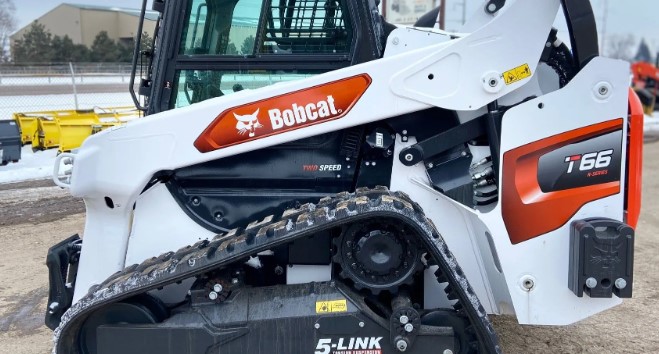
Drive system doesn’t work in either direction
- The hydraulic oil level must be checked and refilled when low.
- If the undercarriage tracks become damaged or jammed, repair or remove jamming immediately.
- If the relief valve becomes faulty, it should be repaired or replaced as soon as possible.
- Clogging of the hydraulic filter or suction line requires a clean-up of the suction line or replacement of the hydraulic filter.
- Hand and foot controls that are malfunctioning require repair or change for functionality purposes .
- An inspection of any damaged drive pump or motor is necessary in order to determine if changing them is required for continued performance
Machine will not move straight or moves jerkily
- The undercarriage tracks may become damaged or jammed due to wear and tear – the repair or remedy for this jamming should be handled by a professional technician.
- If the tracks become worn or loose, it is necessary to adjust the track tension properly or repair them in order to maintain optimal performance of the vehicle.
- Debris, dirt, and foreign objects can build up in an undercarriage track frame which will cause blockages; these must be cleaned out and removed in order to keep the system running smoothly.
Loss of power
- The hydraulic oil filter must be replaced or cleaned if it is dirty.
- If the relief valve is damaged or open, it must be changed or closed.
- If any of the transmission parts are worn or defective, they should be inspected and replaced where necessary.
- A defective input drive shaft can be repaired or a new one installed.
- Air leaks in the hydraulic system must be bled out to ensure proper functioning.
Drive system overheating
- The technician must check the hydraulic fluid level and add more if necessary due to a low level of hydraulic fluid.
- To ensure proper operation, it is important that the technician changes or cleans the hydraulic filter as it may be dirty.
- If there are any issues with the relief valve, then rebuilding or installing a new one may be needed.
- Inspection and replacement of defective hydraulic motors or drive pumps is essential for smooth functioning of systems.
- Clogged cooling fins on the oil cooler should be cleaned regularly in order to prevent overheating problems in machinery components due to debris buildup inside them.
- Excessive loading must be reduced in order to prevent strain on drive systems which can lead to operational failure over time due to overloads beyond their capacity limits
Excessive noise
- The oil viscosity must be checked and adjusted as necessary. If incorrect, the oil should be drained and refilled with the proper grade of oil.
- Air in the hydraulic system needs to be bled out for optimum performance.
- Worn hydraulic motors or drive pumps should be inspected and replaced if necessary.
- Any worn or defective mechanical components of a drive system should be examined for any defects or damages, then repaired when needed .
Bobcat T66 Problems: Hydraulics
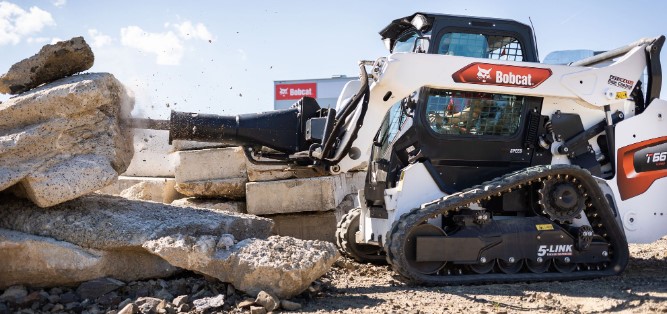
Hydraulic system has overheating
- The hydraulic pressure should be adjusted correctly to ensure proper functioning of the system.
- Misadjusted or defective main relief valves should be adjusted or replaced as needed.
- Dirty hydraulic oil should be changed regularly to maintain system efficacy.
- If the hydraulic system is lacking in oil, it should be replenished immediately for optimal performance levels.
- A defective hydraulic pump may need to be changed or repaired if required for normal operation of the machine’s hydraulics
Boom does not raise or lower
- The lift controls are damaged and need to be changed or repaired.
- The hydraulic oil pump is damaged and needs to be repaired or replaced if necessary.
- The hydraulic control valve has defects that require repair or replacement.
- The hydraulic cylinder is not functioning and needs to be fixed or exchanged for a new one.
- If there is insufficient hydraulic fluid, more should be added as needed
Bucket won’t move
- The faulty bucket tilt controls must be checked and repaired as required.
- A defective hydraulic pump needs to be repaired or replaced with a new one.
- If the hydraulic control valve is found to be defective, it should be replaced or repaired immediately.
- In case of a defective hydraulic bucket cylinder, it should be either replaced or repaired without delay.
- Inadequate levels of hydraulic fluid need to be rectified by adding more as per requirement .
Slow boom or bucket operation
- The technician should inspect the capacity of the hydraulic pump and consider replacing it if necessary.
- To repair any leaks in a hydraulic cylinder, one must replace its seals.
- It is essential to fill up the hydraulic fluid when levels are insufficient.
- If there is an issue with a hydraulic control valve, proper adjustments or repairs must be made accordingly.
- For low pressure in a system, setting correct pressure levels is paramount to performance success .
Bucket or boom movements are jerky
- The air contained in the hydraulic system requires bleeding.
- A dirty hydraulic oil filter element must be cleaned or replaced.
- Contamination of the hydraulic fluid necessitates a complete change of the fluid.
- If a cylinder rod or tube is scuffed, it should be promptly replaced with a new component.
Excessive hydraulic pump noise
- The hydraulic system should be inspected for any leakage or lack of oil, and the necessary action taken to add more hydraulic oil where needed or correct existing leaks.
- A blocked hydraulic filter should be serviced or replaced if required.
- If a plugged suction line is identified, it must be serviced accordingly in order to restore full functionality of the system.
- If a pump is found to be sucking air, it requires immediate attention with an air bleeding procedure being carried out as soon as possible.
- Faulty pump components should either be rebuilt or replaced completely depending on their condition and severity of wear and tear encountered over time
Bobcat T66 Problems: Electrical
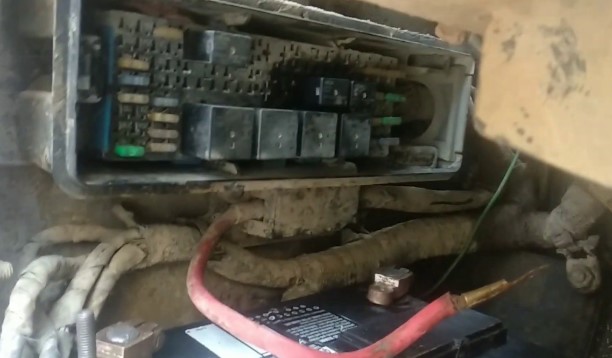
Battery will not charge
- When inspecting electrical cable connections, loose or corroded wires should be tightened or cleaned to ensure proper function.
- Defective battery terminal clamps must be replaced for the system to maintain operability.
- If a battery is failing, it must be changed in order to restore performance of the device.
- Loose or defective belts need to have their tension adjusted or replaced in order for them to work properly again.
Starter turns slowly
- Low Battery Power: It is recommended to charge the battery in order to ensure that it is functioning properly.
- Battery Not Holding Charge: If a battery is not holding its charge, it may be necessary to service the charging system or change out the existing battery for a new one.
- Bad Battery Terminals/Disconnected Wiring: In cases of bad battery terminals or disconnected wiring, it will be important to check cable connections and replace or service terminals as needed.
Starter is not cranking
- The battery is low or faulty – Change or recharge the battery as soon as possible.
- Wiring that has been incorrectly connected or disconnected – Inspect wiring and connect it correctly according to the manufacturer’s specifications.
- Low battery voltage – Recharge the battery in order to restore optimal performance levels.
- Defective starter motor – Repair or replace the starter motor for a smooth running engine start-up sequence and operation.
